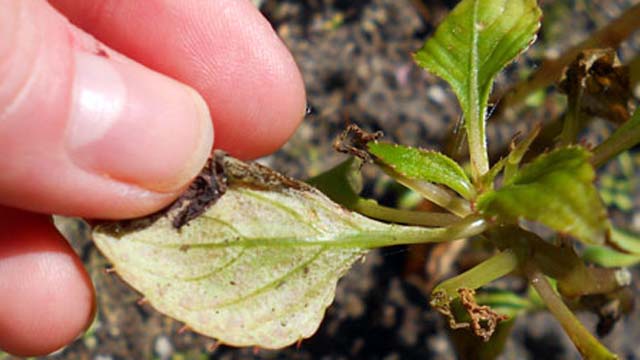Did you plant impatiens in your yard last year? Did it die…suddenly? It wasn’t your fault. What happened? A fungus disease, downy mildew, devastated impatiens across the eastern U.S. Last summer downy mildew spread through impatiens plantings in more than 30 states in the eastern US, including New York. It wiped out impatiens all over the Hamptons.
How Does It Spread?
Downy mildew thrives in moist, humid, cool conditions – typical spring weather here. When plant leaves are wet for four hours, perhaps as a result of overnight sprinkler system operation, the infection can spread. When plants are close together as in a garden bed, the disease is easily passed along. Splashing water can spread the disease spores over short distances, and wind can carry them farther.
How to Spot It
Bedding impatiens is hard to find on the East End this spring, and homeowners in the know are looking for alternatives. If you did find some and plant it, keep a close eye on your plants. If you spot any of the following symptoms on any of your plants, pull up the affected plants immediately, including all the roots, seal them into plastic bags and dispose of them with your household garbage. Do NOT put any diseased plants on your compost pile or toss them on the ground.
 |
|
Look for yellow leaves, white powdery film under the leaves, and curled leaves. (Photo: Michigan State University Extension) |
Here’s what to look for:
– Impatiens leaves begin to turn yellow, and yellow stippling, or spotting, appears. It resembles damage caused by spider mites, or by insufficient fertilizer.
– The plant’s upper leaves curl downward, and the plant looks dry, like it needs more water.
– Leaves and flowers drop off the plant until it is left with bare stems and maybe a few leaves at the top.
– In the end the stems collapse. The plant dies.
This process happens fast. The plants may look fine on Friday and be dead by Monday. It’s important to get infected plants out of the garden as soon as you spot them, to prevent the disease from coming back next year. Along with the active mildew spores, the disease produces another type of spore inside infected plants before they die. This second kind of spore survives in the soil over winter and starts a new round of infection in spring. To stop the disease you have to get rid of these survival spores as well as the active disease spores.
The Good News
OK, here’s the good news. Downy mildew is host-specific and attacks only particular plant species. Brilliant-colored New Guinea impatiens are not affected so you can plant them instead. Another good substitute is wax begonia, which thrives in shade or sun, and so far is not on the deer menu. They come in red, pink or white. Nonstop and tuberous begonias also thrive in shade and bloom lavishly in hot colors. Torenia has rich purple flowers that resemble tiny gloxinias. There’s also coleus, whose colorful foliage comes in shades of green, red, maroon, orange, purple, pink, gold and white in varying combinations and patterns. These plants look terrific all season long and need little care.
Taking a break from impatiens offers a chance to try something new in your shady garden. Embrace the change!






